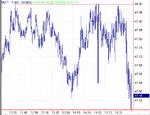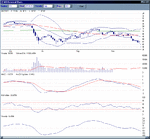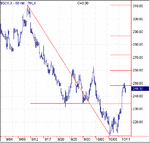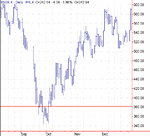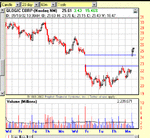tradesmart
Experienced member
- Messages
- 1,286
- Likes
- 22
Thanks for all of your posts on Level II screen interpretation and T/A Naz - great stuff and valuable guidance for us 'students'!
I find it easier to pick up on the Level II rationale than the T/A - have you any plans for a T/A seminar? - a subject that could keep an audience going for quite a few hours I'm sure, or maybe you can recommend a T/A guide text book on the subject?
With plenty of talk about the coming 'Supermontage' system thats coming to replace Level II as we know it now, I've copied an article on the subject below - any comments would be appreciated!
Now what about SuperMontage? Isn't it replacing Level II?
SuperMontage will be upgrading and replacing the Level II as we know it today. SuperMontage will go in tandem with decimalization, and the already enhanced SuperSOES platform. It will deliver a fully integrated execution and order display system. Additionally, it will be addressing issues like market fragmentation, which should make it easier to locate much needed liquidity, along with the best and quickest execution prices for traders.
Unlike the current Level II, where Market Makers are only permitted to enter quotes at their best prices, SuperMontage will allow the Market Makers to post orders and quotes at multiple price levels. Other enhancements include Pre-trade anonymity, and greater transparency. SuperMontage will display five price levels deep on both the bid and offer in each stock. If a trader chooses to view beyond the top five tiers, a new summary scan feature will be available.
Market makers will have increased anonymity capabilities with SuperMontage. Instead of displaying the normal four letter Market Maker ID (MMID), (the acronym "MMID" will be replaced by "MPID": Market Participant Identifier), they will appear on the screen as "SIZE." These non-attributable "SIZE" orders will appear in aggregate form, and will not be identifiable to a specific Market Maker until after execution.
Another feature of SuperMontage is the Reserve Size. A Market Maker may choose to have a reserve aggregate, which will not be visible on SuperMontage. Hence, the reserve order will continually refresh at the price and size displayed by the Market Maker until the order is depleted. SuperMontage will eliminate crossed and locked markets (where the bid price is higher than the offer price).
Regards, TradeSmart
I find it easier to pick up on the Level II rationale than the T/A - have you any plans for a T/A seminar? - a subject that could keep an audience going for quite a few hours I'm sure, or maybe you can recommend a T/A guide text book on the subject?
With plenty of talk about the coming 'Supermontage' system thats coming to replace Level II as we know it now, I've copied an article on the subject below - any comments would be appreciated!
Now what about SuperMontage? Isn't it replacing Level II?
SuperMontage will be upgrading and replacing the Level II as we know it today. SuperMontage will go in tandem with decimalization, and the already enhanced SuperSOES platform. It will deliver a fully integrated execution and order display system. Additionally, it will be addressing issues like market fragmentation, which should make it easier to locate much needed liquidity, along with the best and quickest execution prices for traders.
Unlike the current Level II, where Market Makers are only permitted to enter quotes at their best prices, SuperMontage will allow the Market Makers to post orders and quotes at multiple price levels. Other enhancements include Pre-trade anonymity, and greater transparency. SuperMontage will display five price levels deep on both the bid and offer in each stock. If a trader chooses to view beyond the top five tiers, a new summary scan feature will be available.
Market makers will have increased anonymity capabilities with SuperMontage. Instead of displaying the normal four letter Market Maker ID (MMID), (the acronym "MMID" will be replaced by "MPID": Market Participant Identifier), they will appear on the screen as "SIZE." These non-attributable "SIZE" orders will appear in aggregate form, and will not be identifiable to a specific Market Maker until after execution.
Another feature of SuperMontage is the Reserve Size. A Market Maker may choose to have a reserve aggregate, which will not be visible on SuperMontage. Hence, the reserve order will continually refresh at the price and size displayed by the Market Maker until the order is depleted. SuperMontage will eliminate crossed and locked markets (where the bid price is higher than the offer price).
Regards, TradeSmart
Last edited:

